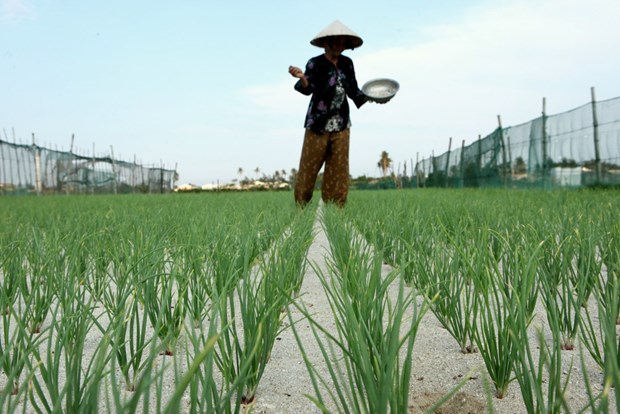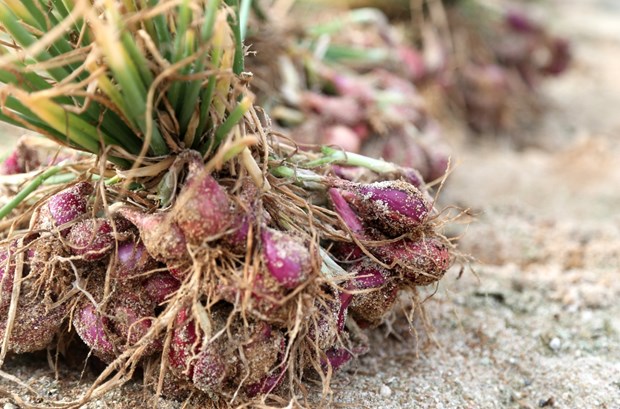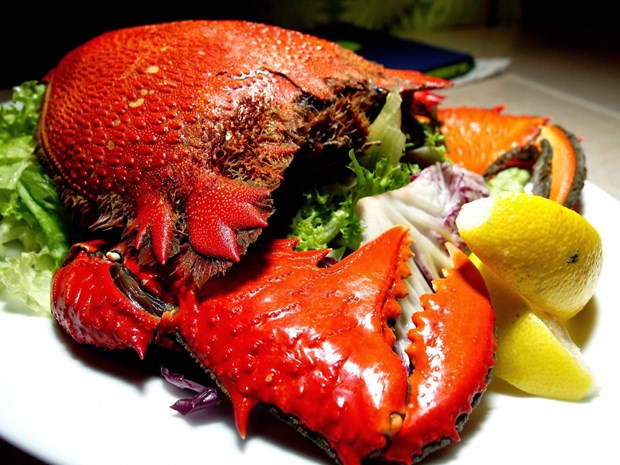On
that tiny island, everything lacks but sand. A year can bear only one garlic
season but annual crops must depend on uncontrollable climates so farmers
decided to intercrop some more shallots. Unexpectedly, after a couple years,
shallots have almost overpassed garlic and become another specialty and main
income of farmers on that island.
Quite
different from other types, shallots on Ly Son bear smaller bulbs but they are
all bright purple, smooth and aromatic.
From the soil…
Ly
Son island (Quang Ngai province) was formed during volcanic activities and the
deposition of sea sand and coral reefs million years ago. Today, the island is
the remnant of a five-crater volcano, created the 5 main reservoirs of fresh
water for the islanders. The eruption and erosion of volcanoes spread over the
surface of Ly Son Island with fertile basaltic and mineral rich red soil.
However,
neither the climate nor the soil of that island seems to support food plants.
Islanders only grew short-term crops until the garlic has planted all over the
place. Garlic became a specialty of Ly Son but the tropical and coastal weather
during 6 months of garlic crop does not often treat them well. Therefore, the
farmers started to intercrop shallots and garlic.
More
experiences, they’ve laid shallot fields along the south of the island, from
the regenerated pieces on hills to used-up pieces of land next by the coast.
They spread a thick layer of smooth basalt soil on the ground then another
layer of organic fertilizer from available materials as leaves or seaweed, and
finally they cover by a layer of coral sand.

Shallot fields.
Having
enough nutrition and needed minerals, just about 45 – 60 days after planted
farmer can harvest the new crop. They easily take a whole bunch of chubby yet
firm and shinny shallots from the ground. The coral sand layer plays double
roles, polishing shallot bulbs as well as draining all excessed water.
Therefore, shallots of Ly Son are not only beautiful but also long lasting.
… to the quality of
shallots
It’s
absolutely nonsense when comparing Ly Son shallot to any other types in
Vietnam, even the one from “the capital of shallots” – Soc Trang province,
because its quality is totally different. Ly Son shallot bulbs are small and
even while other places’ – where people have planted shallots in mixture of ash
and husk - are much bigger; Ly Son shallots’ husk is smooth, glossy, and very
thin; and their scales are purplish and firm.

Purple shallots in Ly Son island.
Besides
its amazingly delicious flavor, shallots from this volcanic island have another
valuable characteristic, which is not pungent at all. Indeed, their flavor is
mildly spicy yet aromatic and sweet so they can be eaten raw or made salad as
western style.
The
remote Ly Son island has not only garlic or shallot but also delicious seafood.
Depending on the thickness of wallets, visitors can have spanner crabs (Ranina
ranina), red slipper lobsters, and groupers or more affordable seafood as moon
snails or also call necklace shells (Naticidae), limpets, and seasonal seaweed.
All local fresh seafood is much better with shallots. Simply just oil shallots
and a couple cloves of garlic before roasting the whole spanner crab and
condiments; complicatedly we can thinly slice raw shallots, mix them with lime
juice, herbs and cooked limpets’ flesh to make a nutritious and delicious
salad; or we can pickle the shallots and have them with steamed groupers. They
all are great and flavorful dishes.

Roasted spanner crabs with shallots.
Not
only an irreplaceable spic in any kitchen but shallots themselves are the best
natural antibiotics since they don’t cause any side effects.
Russian
pharmacists claimed that substances of shallot were not inferior to any
antibiotics after comparing them to hundreds of antibiotic medicines. The
pharmacists believe that purple shallots can pasteurize the respiratory tube,
especially when they are eaten raw or pickled. Many people have found that raw
shallots might be unable to eat because of their spicy taste and pungent smell
but indeed raw shallots can really help to disinfect the respiratory area due
to the mechanism of tears and rheum. This mechanism allows the body to remove
impurities from the mucous membranes along respiratory tubes before bacteria
turn them to infection.
From
the top of Thoi Loi mountain, one of the 5 shut down volcanoes, taking a look
beneath, there are continuously spreading shallot fields as an uneven giant
chessboard. The area of Ly Son island is about 10 km2 but 1/3 of it is for
garlic and shallot fields. It was supposed to be fall already but the sun heat
had still burn sedimentary rocks on the island. Everywhere farmers were
harvesting shallots on their fields. Some were picking, some were choosing
while others were bunching shallots; even children were helping their families
after school. Just a couple more days, the fields would stay sandy white and a
couple weeks after, islanders would prepare for another new shallot crop to
make their garlic always in company.
Single
garlic cloves in Ly Son island are not similar to the purple type of single
garlic in Phu Yen district (Son La province). It is a regular type, which has 6
or more cloves gather on a disk, but during harsh conditions, there are only
some to dozens garlic units left on a field and they all are single clove.
By Thu Pham